




By Kiara Williams Staff Writer
ig
Brothers Big Sisters
Twin Cities (BBBS) continues to emphasize child safety while expanding its mentorship program, serving more than 2,000 youth across the region. With a structured safety framework and increased community outreach, the organization is reinforcing its commitment to safeguarding children and fostering meaningful mentor relationships.
“This program is about more than just mentorship. It’s about creating a foundation of trust and protection.”
Child safety protocols
Ensuring the well-being of participants remains a cornerstone of BBBS’s mission. The organization provides training for Littles (ages 8-13), Bigs (mentors 18 and older), and parents to recognize and report harm.
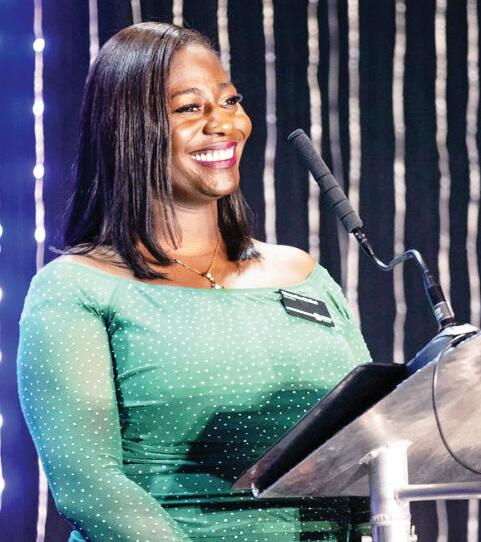
or school environments. BBBS employs structured check-ins, including monthly meetings during the first year and quarterly follow-ups, to encourage disclosures and provide support.
Incident response
BBBS adheres to a Critical Incident Process, ensuring all concerns raised by Littles, Bigs, or parents are documented and investigated. If reports involve suspected abuse or neglect, BBBS follows mandatory reporting laws, escalating cases to law enforcement or child protective services as required. Staff and volunteers receive ongoing education in identifying and reporting abuse.
“Transparency and accountability are key,” Kisob said. “We take every report seriously and ensure that all staff, mentors and parents understand their role in keeping children safe.”
Hallie
Brown
96 years inspire an ambitious vision
By Aria Binns-Zager Staff Writer
n April 1, Hallie Q. Brown
Community Center celebrated its 96th anniversary with an event that honored its history, highlighted its present work, and laid out an ambitious vision for the future.
Executive
Director Benny Roberts delivered an impassioned speech about the center’s role in Rondo, the historic heart of St. Paul’s Black community, and called for continued investment in its people and resources.
college students are broke.’” For nearly a century, Hallie Q. Brown Community Center has provided vital programs and services to Rondo residents. Its success, Roberts emphasized, has always been driven by the urgency of community needs.
“This organization was not started with a business plan,” he said. “There were community needs and no time. You had to have action.”
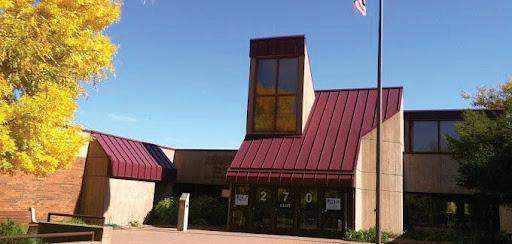
“This program is about more than just mentorship — it’s about creating a foundation of trust and protection.”
In 2023, the national BBBS network mandated Your Child’s Personal Safety Training, stan-
“Our goal is to ensure every child feels safe and empowered to speak up if something is wrong,” said Princess AwaAda Kisob, BBBS Twin Cities’ vice president of programs.
By Clint Combs Staff Writer
fter decades of mistrust between the Minneapolis Police Department and the community, the City Council is investing in alternative violence prevention initiatives. On March 27 the Council approved funding for five organizations: Restoration, Inc. and A Mother’s Love, which provide services on the Northside of Minneapolis; and T.O.U.C.H. Outreach, Sabathani Community Center, and MAD Dads serving the Southside.
in Zone 2, a Northside area that includes the historically high-need intersection of 36th and Penn. Weeks earlier, Rev. Jerry McAfee’s nonprofit, 21 Days of Peace, had its funding request pulled after two of its members were involved in a shootout off-the-clock. The sudden removal of 21 Days of Peace left Zone 2 without a dedicated violence prevention group, raising concerns among residents and local leaders about potential gaps in service.
In response, the Council passed a resolution allowing

The Council also approved a proposal by Councilmember Jamal Osman to move $640,000 from public safety funds to support violence prevention efforts in the Cedar Riverside and Elliot Park neighborhoods. However, these funding decisions follow weeks of debate, particularly concerning the loss of service
community groups to bid on providing services in Zone 2, but no immediate replacement has been secured. “It really was just helping Osman figure out his funding stream because the money was there for Zone 2,” said Councilmember LaTrisha Vetaw.
“We had lots of conversations
■ See HAMSTRING on page 5
dardizing safety education across all chapters. In 2024, BBBS Twin Cities reported that fewer than 4% of participants disclosed harm, with only one case involving allegations of sexual abuse — none of which were linked to mentors.
Instead, reports primarily reflected concerns about home
Comprehensive safety training
BBBS integrates safety discussions throughout its mentorship process. Littles engage in personalized safety sessions during enrollment, where they establish boundaries and
■ See BBBS on page 5
“I’ve dedicated my whole life and service to community, but it’s different when you’re serving the community that gave you your first job,” Roberts said. “It’s different when you’re serving the community that says, ‘You’re going to college. Let me put some money in your pocket because I know
Now the center is preparing for its next chapter — a 25,000-square-foot expansion that Roberts described as long overdue.
“I’ve been mapping out a pre-capital campaign plan and designated a request for a 25,000-square-foot expansion to this building,” he announced. “And why? It’s because of the majority of this room.”
■ See VISION on page 5
By Clint Combs Staff Writer
ayor Jacob Frey is seeking a final term in office, telling voters at the Northside Candidate Forum at Zion Baptist Church, “I’m running for one final term to get the job done. I want to partner with you all to make that happen.”
Frey faces eight challengers in his bid for a third term, including Ward 11 Councilmember Emily Koski; Rev. DeWayne Davis of Plymouth Congregational Church; Jazz Hampton, CEO of legal services app TurnSignl; and Brenda Short, a former retail and corporate worker known for her criticisms of the Democratic Socialists of America (DSA).
DSA-backed candidate Omar Fateh was absent from the forum due to state Senate deliberations running overtime.
At the forum, Frey highlighted the Great River Landing Project as a model for criminal justice reform. “We should have wraparound services that make sure that people have homes, jobs, and a direct connection to the community,” he said, emphasizing support for those reentering society after incarceration.
Hampton, whose TurnSignl app helps drivers record interactions with police, criticized the lack of resources for formerly incarcerated individuals. Citing the case of Marvin Haynes, whose wrongful conviction was overturned due to faulty eyewitness reports,
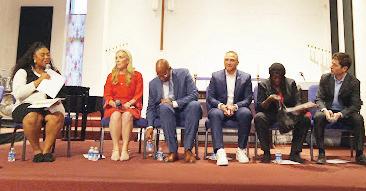
Hampton said, “He didn’t have a cell phone to put a number down on a piece of paper to get a call back for an interview,” referring to the challenges inmates face when transitioning back into society. “These are wraparound services that we need to provide.”
Davis underscored the role churches play in filling financial gaps for entrepreneurs with criminal records. “If you have been convicted and incarcerated, no one wants to loan you anything. Churches
who just need someone to believe in them,” he said. Koski pointed to job opportunities within the city. “We have 4,000 jobs at the City of Minneapolis, over 3,000 part-time jobs,” she said, touting the Southside Community Center and the council’s funding of the Fourth Precinct as ways to bolster the Community Safety Department.
Davis expressed optimism about the Neighborhood Safety Department’s efforts to increase public trust through
“I’m running for one final term to get the job done.”
have been very good at backing people with good ideas
data transparency. Meanwhile, Short, a self-described “Peace
Officer,” dismissed the concept of reform entirely. “I don’t believe in reform. I believe in rebuilding,” she said. Frey also cited his administration’s initiatives, including the Office of Safety Commissioner and mental health response services, as commitments made in the wake of George Floyd’s killing by Minneapolis police. “I’m sure there are people now that say we’re not going to be able to set up a Safety Center, either on the South Side or the North Side, that has all these services under one roof,” Frey said. “Doubt it now. We’re going to do that too.” Candidates also addressed labor issues, with many voicing support for public unions.
Short referenced a March 14 strike by workers at Providence Place in Minneapolis. “Our workers have the right to
■ See MAYOR on page 5
By Aria Binns-Zager Staff Writer
The 13th Annual People of Color Career Fair will take place on Tuesday, April 15, from 10 am to 3 pm, at the Saint Paul RiverCentre. This free event aims to connect professionals of color with over 50 top Minnesota employers, including U.S. Bank, Andersen Corporation, Ameriprise, Blue Cross Blue Shield of Minnesota, Children’s Minnesota, and RBC Wealth Management. Some employers will be conducting on-the-spot interviews.

unemployment rates and barriers to stable employment.
According to the Minnesota Department of Employment and Economic Development, in 2020, the unemployment rate for Black Minnesotans was 8.7%, 2.7 times higher than the 3.2% rate for white Minnesotans. Although this marked an improvement over the previous decade, the disparity remains significant.
Furthermore, a report by the Minneapolis 2040 initiative highlighted that the unemployment rate in Minneapolis for Black individuals was approximately three times higher than that of white non-Hispanics.
not be effectively addressing these issues. Additionally, there is a growing trend of companies publicly scaling back their DEI commitments. In Minnesota, several corporations, including 3M, have removed DEI-related content from their websites following executive orders from President Donald Trump. Such actions raise concerns about the sincerity and longevity of corporate commitments to diversity and inclusion.
Attendees can benefit from various services designed to enhance their job search experience. A networking breakfast will provide opportunities to engage with executives, recruiters, and hiring managers from leading companies. Additionally, free professional headshots will be offered, courtesy of Best Buy. The event also features “The Huddle Lounge,” facilitating a relaxed conversation between professionals of color and corporate decision-makers.
Fair, highlighting its significant impact on the community.
The People of Color Career Fair has garnered support from notable city officials, CEOs and working professionals alike. Mayor Melvin Carter has expressed strong support for the People of Color Career

In a previous statement, he emphasized,”In the Twin Cities, we have an incredibly talented and diverse workforce actively seeking high-paying careers. The People Of Color Career Fair helps connect these professionals with employers across our region.”
Additionally, Mayor Carter also noted the fair’s role in addressing employment disparities.
“We have been waiting for the return of the People Of Color Career Fair. The type of access that this Career Fair provides to Professionals of Color is unmatched.” These remarks underscore the importance of the career fair in fostering equitable employment opportunities within the region.
Chris Galvin, president and CEO of Andersen Corporation, emphasized the company’s commitment, noting, “Ander-
sen has been a Premier Sponsor since the inception of the People Of Color Career Fair… Andersen was all-in, understanding the importance of expanding networks and committing to being in the room.”
The career fair can be a helpful resource for all those who attend, but especially for those hired. Emmanuel K. Dickson, client experience consultant for the Royal Bank of Canada, RBC, stated, “This is a great opportunity no matter your career level. You will be thrilled by the conversations, so don’t sleep on it. They want to hire you!”
Job security remains a significant concern for people of color in the Minneapolis-Saint Paul area, as systemic disparities continue to affect employment opportunities and outcomes. Despite comprising a growing portion of the workforce, these communities often face higher
By Jasmine McBride Associate Editor
Project Home, operated by Interfaith Action of Greater Saint Paul, provides emergency shelter and supportive services to families experiencing homelessness in Ramsey County. Since March 2021, Project Home has been located at the Provincial House, 1880 Randolph Ave. in Saint Paul. Now a recent opportunity for expansion has opened up new possibilities.
On March 31, Interfaith Action took ownership of 1010 Bandana Blvd. W., previously
experiencing homelessness, is also supporting the project with leadership from Director of Housing Stability Keith Lattimore and the Ramsey County Board of Commissioners. “Addressing homelessness requires collective effort and strategic investment. Interfaith Action’s expansion will provide immediate relief while setting families on a path toward long-term stability,” Lattimore stated.
“The growth and impact of Project Home, which started as a mobile shelter hosted by Interfaith Action’s member faith communities, shows this

operated as the Best Western Plus Como Park Hotel. The Walz-Flanagan administration awarded $6 million administered by the Minnesota Department of Human Services for this acquisition through the American Rescue Plan State Fiscal Recovery Fund. Ramsey County, longstanding partners to Interfaith Action in their work providing emergency shelter to families
strength in action,” said CEO Liliana Letran-Garcia. “This milestone enables Interfaith Action to write the next chapter of our story with ownership of a new home, providing shelter to even more unhoused families while continuing to strengthen our roots and relationships in the community.”
She said this transformational opportunity allows Interfaith Action to establish a
permanent hub in Saint Paul to address an ever-growing community need — provid-
“Strength
is built when communities of faith and wisdom gatherings work together to support their neighbors in achieving economic stability and mobility.”
ing emergency shelter, food, clothing, and other stability needs. Plans for the new location include the expanded space for the organization’s Project Home (one of only two emergency family shelters in Ramsey County’s Coordinated Entry system), other programming fostering economic stability and mobility, and administrative operations.
The acquisition of this facility comes at a critical time, as Minnesota faces a growing homelessness crisis. According to the Wilder Research 2023 Minnesota Homeless Study, the number of people experiencing homelessness in the state has reached its highest levels in decades. In the Twin Cities alone, over 12,000 individuals experience homelessness on any given night, with families making up a significant portion of those affected.
Minneapolis has also seen fluctuating numbers in homeless encampments. As of March 2025, the city reported 16 active encampments with 43 residents, a marked decrease from prior months. This reduction is attributed to enhanced police enforcement and community
outreach, though advocates caution that addressing homelessness requires long-term housing solutions rather than temporary clearances.
“The work of Interfaith Action is brought to life by community. Strength is built when communities of faith and wisdom gatherings work together to support their neighbors in achieving economic stability and mobility,” said LetranGarcia.
Interfaith Action’s new fa-

KThe persistent employment disparities faced by Black and brown communities in the Minneapolis-Saint Paul area are further exacerbated by challenges within diversity, equity and inclusion (DEI) initiatives. While DEI programs aim to address systemic inequities, their effectiveness has been questioned, particularly regarding tangible benefits for Black professionals.
“In the Twin Cities, we have an incredibly talented and diverse workforce actively seeking high-paying careers.”
Studies indicate that many DEI initiatives have not significantly improved conditions for Black employees. For instance, a report from Mercer highlights that gaps in pay, career progression, health and wealth continue to adversely affect Black Americans, suggesting that current DEI efforts may

cility will not only offer emergency shelter but also critical resources such as rapid-exit housing case management, workforce training, and educational support. These services
Obituary
These disparities are not only reflected in unemployment rates but also in wage gaps and limited access to education and training, which are critical for career advancement and job security. Addressing these issues requires comprehensive strategies that include equitable hiring practices, targeted educational programs, and policies aimed at eliminating systemic biases in the labor market, which are some key elements that the People of Color Career Fair want to radicalize.
With its comprehensive offerings and strong community backing, the People of Color Career Fair stands as a pivotal event for fostering diversity and inclusion within Minnesota’s workforce and providing opportunities for our friends, families and co-workers.
Professionals interested in attending are encouraged to register in advance through the official website. Transportation to the fair is made convenient with free Metro Transit passes available for attendees, ensuring stress-free travel to and from the venue.
Aria Binns-Zager welcomes reader responses at abinns@ spokesman-recorder.com.
are crucial in breaking the cycle of homelessness and fostering self-sufficiency among vulnerable populations.
Although no date is confirmed, the space is set to open in the summer of this year. With the establishment of this new hub, Interfaith Action of Greater Saint Paul is positioning itself at the forefront of community-driven solutions to homelessness. The organization’s ongoing efforts highlight the power of faith-based and local partnerships in driving meaningful, sustainable change for families in crisis.
Jasmine McBride welcomes reader responses at jmcbride@ spokesman-recorder.com
Katheryn Washington
Sunrise, March 23, 1940 - April 01, 2025, Sunset
atheryn Ann Washington was born to Donald and Bette Session on March 23, 1940, in Minneapolis, Minnesota. Katheryn was married to Robert L. Washington, who preceded her in death.
Katheryn was educated in the Minneapolis school system. She later moved to Detroit, Michigan, with her mother, where she graduated from Central High School. She accepted Christ at an early age. Katheryn was a soldier of The Salvation Army Grandale Corps. She enjoyed women’s ministries and going out to Echo Grove Camp. Katheryn also loved going to St. Patrick Senior Center. She enjoyed her family, book club, and going to Bible study.
Katheryn was always caring, giving, and going the extra mile for others. She loved any child like her own. Katheryn departed this life on April 1, 2025. She was preceded in death by both parents and son Robert Washington.
Katheryn leaves to mourn her passing

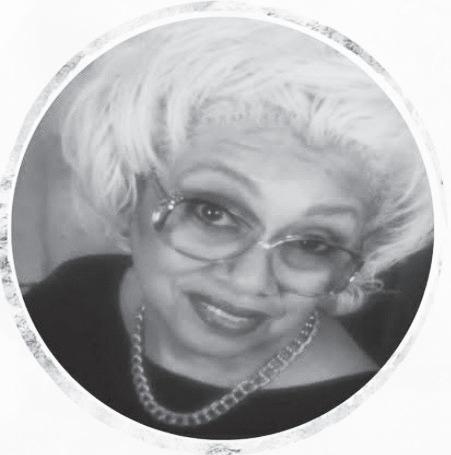
and cherish her memory her children, Lorie Washington, Lesley Perkins, and Betty Washington (Eric); 10 grandchildren and 10 great-grandchildren; and a host of other relatives and friends who are family too numerous to name but never forgotten. The funeral service will be held on Friday, April 11, 2025. For those who cannot attend but would like to support, gifts can be sent to 15938 Indian St, Redford, Michigan, 48239. Minnesota Spokesman-Recorder April 10, 2025
By Clint Combs Staff Writer
Minnesota lawmakers have introduced the Medical Debt
Reset Act, setting aside $5 million to help the nonprofit Undue forgive up to $500 million in medical debt. The legislation aims to provide financial relief to Minnesotans with a household income at or below 400% of the Federal Poverty Guidelines, or those whose medical debt equals or exceeds 5% of their income.
Undue has successfully managed similar debt relief efforts in New Jersey, Rhode Island, Arizona, Connecticut, Illinois and St. Paul.
Medical debt is a growing
crisis in the U.S., disproportionately impacting lower-income families and communities of color. Rising health care costs have left many Americans struggling to pay for essential treatment, forcing them to make difficult financial decisions. The proposed act underscores the urgent need to address this burden, which can
her family’s struggle with medical debt. She and her husband paid $150,000 outof-pocket for their daughter’s lymphoma treatment. “We have put $21,000 on medical credit cards and struggle to make payments,” Lillemo told a crowd of supporters, many wearing blue shirts reading “Faith in Minnesota.”
“No one chooses to be buried in mountains of debt due to their medical care.”
devastate credit scores, limit access to housing, and create lasting economic instability.
Jan Lillemo, a self-employed consultant, shared

The Lillemos, whose income fluctuates due to Jan’s selfemployment, have refinanced their home, cashed out their retirement savings, and moved in with Jan’s parents to stay afloat. Their story reflects the sacrifices many families make to cover health care costs.
Hannah MacDougall, a University of Minnesota student and local advocacy group representative, highlighted the impact of medical debt on rural residents. “Our analysis showed that those most affected by health care affordability in Minnesota are people living just above the Federal Poverty Level, as well as Black and Hispanic residents,” Mac-


Hello there! My name is Ayanna Quamina and I’m a Naturopathic Doctor. Although it’s based on a very traditional form of medicine and has been around for decades, it’s not super well known as an option for health care. So, because I’ll be writing a regular column for MSR, I thought it would be helpful to first fill you in a bit about my story.
Background
I’ve always known I wanted to be a doctor. However, that got sidetracked in high school after I interviewed about half a dozen MDs (Doctor of Medicine), who’d advised me against doing medicine because I told them “I wanted to help heal people.” They meant well, just said it wouldn’t be easy due to the time limitations, high stress, and insurance hoops we all know about today.
Fast-forward three years and I was living in Los Angeles, frustrated and uninspired from working in the music business, realizing they weren’t interested in supporting the people who actually made the music. I remember sitting at my cubicle one night, desperately searching the internet for my perfect career and stumbling upon Naturopathic Medicine.
I was so excited! After years of going back and forth, I’d finally found what my heart and intellect had been looking for. I moved back home (to Minnesota), applied to my school of choice, and I’ve been helping people heal for the past 16+ years.
Naturopathy?
Naturopathic medicine is a distinct health care profession that emphasizes prevention, treatment, and optimal health. We use therapeutic methods to encourage each patient’s own self-healing process; all based on a combination of modern and traditional protocols.
We are all honor-bound by ”Six Principles of Naturopathic Medicine” —the foundation of our medical education and patient care:
Do No Harm (Primum Non Nocere)
Naturopathic physicians follow three guidelines to avoid harming our patients:
• Utilize methods and medicinal substances that minimize the risk of harmful side effects, and use the least force necessary to diagnose and treat.
• Whenever possible, avoid the harmful suppression of symptoms.
• Acknowledge, respect, and work with each individual’s self-healing process.
The Healing Power of Nature (Vis Medicatrix Naturae)
Naturopathic medicine recognizes that there is an intrinsic self-healing process in everyone. We work to identify and remove the obstacles for healing and recovery, and our overall intention and approach is to support that selfhealing process.
Identify and Treat the Causes (Tolle Causam)
Naturopathic physicians identify and remove the underlying causes of illness, rather than eliminate or suppress just the symptoms.
Doctor as Teacher (Docere)
We educate our patients and encourage autonomy and self-empowerment of their own health. We also recognize the therapeutic value of maintaining a positive doctorpatient relationship.
Dougall said.
One of the hardest-hit areas is Roseau County in northwestern Minnesota, where 8% of residents struggle with medical debt. According to Debt in America’s interactive map, rural counties acquire more medical debt than urban areas, despite urban areas often reflecting more diverse communities.
Limited access to health care, lower income levels, higher uninsured rates, health care system strain, and more facilitate these outcomes; but this does not mean urban areas are not also greatly affected. In Hennepin County, home to Minneapolis, 2.25% of residents have medical debt in collections. The median medical debt in collections for the county is $1,200.
Medical debt gained renewed attention following the tragic shooting of Brian Thompson, the former CEO of Minnetonka-based UnitedHealthcare. The incident sparked public outrage and reignited discussions on the high costs of medical care in America.
Alfred Babington-Johnson, a longtime advocate, linked the issue to the broader struggle for social justice, invoking

Dr. Martin Luther King Jr.’s vision of the “beloved community.” Quoting King, he emphasized, “No one chooses to become desperately ill requiring extraordinarily expensive interventions. Furthermore, no one chooses to be buried in mountains of debt due to their medical care.”
St. Paul Mayor Melvin Carter underscored the moral responsibility to act. “Our faith should never allow us to be quiet,” he said, referencing St. Paul’s previous success in forgiving $40 million in medical debt for nearly 32,000 residents under the American Rescue Plan.
Jennifer Schultz, a health care advocate, urged lawmakers to support the initiative. “Nobody chooses to get sick and fall into medical debt,” she said.
While medical debt relief programs have gained widespread support, some experts
question their long-term impact. A Stanford study examining Undue’s past efforts found that while debt forgiveness provided temporary relief and modestly improved credit access for some, it had no significant impact on financial outcomes overall.
The study concluded that “medical debt is a symptom, not an underlying cause” of financial instability, highlighting the need for systemic health care reforms.
The debate over medical debt continues to shape policy discussions in Minnesota and beyond. As lawmakers consider the Medical Debt Reset Act, the stories of affected families serve as a reminder of the human cost of an unaffordable health care system.
Clint Combs welcomes reader responses at ccombs@spokesman-recorder.com.
Treat the Whole Person
Naturopathic physicians treat each patient by taking into account their individual physical, mental, emotional, genetic, environmental, social and spiritual factors. We understand that all of these areas can play an important part of each person’s overall health.
Prevention
Naturopathic doctors (NDs) emphasize the prevention of disease by assessing each patient’s overall risk factors, heredity, and susceptibility; and we identify and assess appropriate interventions with our patients to help prevent future illness.
Similarities to other doctors
There are a few things Naturopathic Doctors have in common with other medical practitioners, like MDs or DOs (Doctor of Osteopathic):
1. We attend a four-year accredited, graduate-level medical school.
2. We spend the first two years learning the same biomedical sciences, and the second two applying what we’ve learned in a clinical setting.
3. We take professional board exams, have a regulatory medical board, and have to complete at least 25 hours of continuing education every year in order to maintain our license or registration.
We also have some differences.
Differences from other doctors
1. In addition to the biomedical sciences, naturopathic medical curriculum includes clinical nutrition, physical medicine, acupuncture, homeopathic medicine, botanical medicine, psychology, hydrotherapy, and counseling.
2. Each state has its own regulations that define the scope of practice for the Naturopathic doctors that practice there. For instance, an ND practicing in California can prescribe pharmaceutical medication and give IV treatments, whereas registered Minnesotan NDs order diag-
nostic labs and tend to focus more on nutrition, counseling, and supplementation. We are also different from other alternative practitioners. Over the years I’ve been called by multiple titles like naturopath, homeopath, naprapath. Unfortunately, all of these are incorrect.
What you can count on a Naturopathic Doctor for Naturopathic doctors are trained to treat all medical conditions, ages and backgrounds, but most tend to
focus on a particular population or treatment area. Some of the most common conditions I treat are those related to digestive symptoms, hormone imbalance, diabetes, high blood pressure, cholesterol imbalance, mental health, stress management, and sleep support, among others.
So, why would you see a Naturopathic Doctor?
1. You want a doctor who will treat you, not just your illness.
2. You want personalized treatment.
3. You want to treat the root cause of an illness, not just the symptoms.
4. You want to actively participate in managing your own health.
5. You have a condition or diagnosis and want options other than pharmaceuticals.
If you are interested in finding a Naturopathic Doctor, check out the AANP (www.naturopathic.org), MNANP (www.mnanp. org), or connect with me directly at www.drayannaq.com/


By Kiara Williams Staff Writer
For Brayshaun Gibson, founding a junk removal business wasn’t a lifelong dream — it was an accident. The owner of JunkNMyTrunk Junk Removal stumbled into the business in 2024 after posting a simple Facebook status offering help with moving and junk removal.
“I had gotten access to a trailer,” Gibson recalls. “I made a Facebook status and asked who needed something moved or picked up, and my inbox went crazy. My phone was going off every day for like three months straight. And then I was like, oh, this is something I could possibly do for a long time and take seriously — and that’s what I did.”
Since officially registering his business in September 2024, JunkNMyTrunk has grown from a solo hustle to a structured operation. “I have two full-time employees,” Gibson shares. “And as demand grows, I have access to as many people as I need, honestly.”
More than just junk removal
While junk removal is the company’s primary service, Gibson has expanded into demolition work and has ambitions for even more growth.
“We’re looking at a big project right now for a company

Gwhere we’ll be doing a lot of demolition,” he says. “Eventually, we’re going to get into dumpster rentals and portapotties, but as of now, it’s primarily junk removal.”
His business plays an essential role in maintaining the community, particularly in underserved areas. “A lot of people leave stuff outside, so we’re cleaning up the neighborhood and the environment,” Gibson explains.
“Landlords deal with a lot of bogus tenants that leave stuff inside the home, so we help declutter spaces for entrepreneurs, business owners, and real estate investors. Anytime you can make a place cleaner, it’s a better place to be.”
Beyond aesthetics, Gibson sees his work as a way to contribute to the economic revitalization of Minneapolis. By providing professional cleanup services, his business helps property owners repurpose abandoned spaces for new housing and businesses, ultimately contributing to community stability. Additionally, as his business continues to expand, it creates more employment opportunities.
Challenges and rewards
Running a business comes with its challenges, and for Gibson the hardest part has been time management, mon-
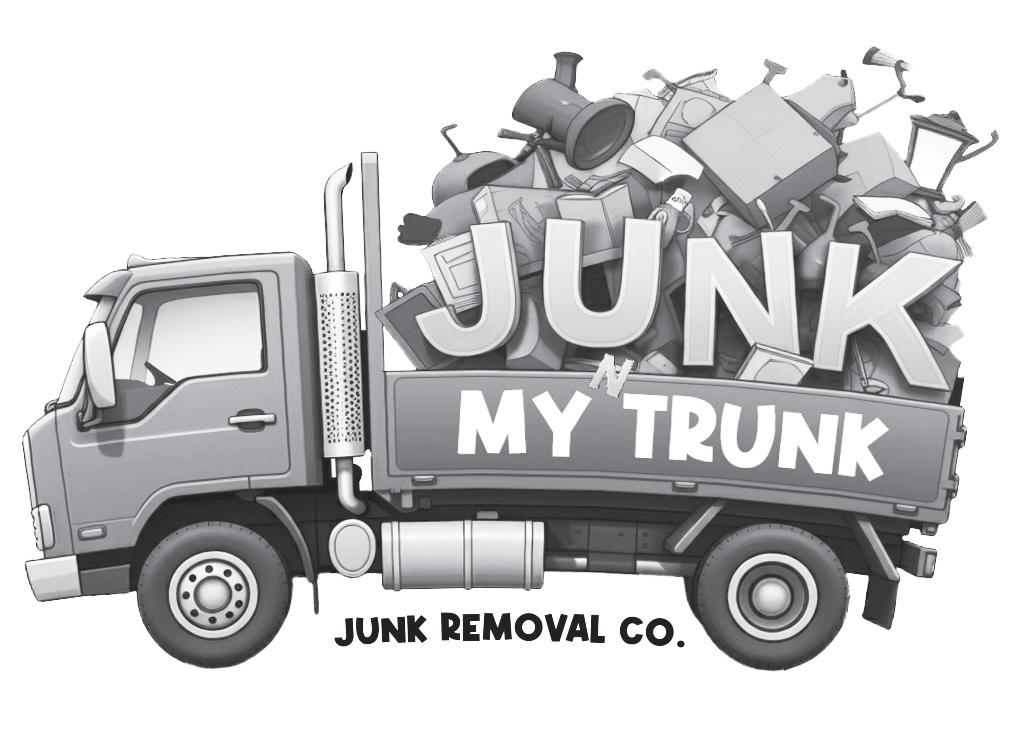
ey management, and finding reliable help.
“I’ve had to learn a lot on the go,” he says. “When you’re running a business, there’s no blueprint, especially if you don’t come from a background of entrepreneurs. You have to figure things out and adjust as you go.”
Despite these hurdles, he says the rewards make it worthwhile. “Having a positive impact on other people, being able to help people control their own destiny, and making my own money — those are the best parts.”
Looking ahead, Gibson has a vision beyond just growing his company. “I want to focus on education — helping people start their own businesses,” he says. “There are so many people out here with skills and ideas, but they don’t know where to start. If I can help someone else avoid some of the struggles I went through, that’s a win.”
Gregory Donald Williams
Sunrise, December 9, 1953 - April 1, 2025, Sunset
regory Donald Williams passed away on April 1, 2025, due to complications of Amyloidosis (ATTR) after receiving a heart transplant in 2019. He was born December 9, 1953, in Minneapolis, Minnesota, to Lorenzo D. and Lillian H. Williams; who are now deceased. Greg and his wife Lori Young-Williams were residents of Lauderdale, Minnesota, at the time of his death.
Greg worked at the University of Minnesota for 40 years in Facilities Management, starting as a student B & G worker and ending as a Team Manager. He was building manager for the Ramsey County Property Services and Assistant Director of Facilities Management for Metro Transit Facilities. He was a member of the International Facilities Management Association (IFMA), Board Member of IFMA MSP, and served as president of the IFMA Academic Facilities Council. He was also Chair of the Ramsey County Parks and Recreation Commission and Chair of the Lauderdale Sustainability Council.


Lessons learned
Reflecting on his journey, Gibson acknowledges the personal growth that has come with it. “I was self-sabotaging at times in life,” he admits.
“I went to jail, got my stuff together while I was in there. Got my mind together, got my experience together. I created a plan, came out, executed the plan, made some adjustments,
and now I’m here.”
Gibson credits his incarceration time as a turning point in his life, giving him the clarity and discipline to build something for himself. He believes that mindset is a crucial factor in success. “Success doesn’t come from luck — it comes from discipline and effort,” he says. “I had to get serious about what I wanted and stop making excuses.”
His advice to aspiring entrepreneurs? “Focus. Hone in on exactly what you want to do, and do it. Don’t cut corners.”
The future With plans for expansion, Gibson hopes to turn JunkNMyTrunk into a multi-service operation. “I see us getting into construction cleanup, more demolition work, and eventually waste management,” he says.
“There’s a lot of opportunity in this industry, and I want to make sure we stay ahead.”
As he grows his business, Gibson also hopes to create job opportunities for others, particularly those looking for a fresh start. “There’s a lot of people who just need an opportunity,” he says. “If I can create jobs and help someone else get on their feet, that’s a big deal to me.”
From overcoming personal challenges to building a business that benefits his community, Brayshaun Gibson is proving that sometimes the best opportunities come from unexpected places. And as he continues to grow JunkNMyTrunk Junk Removal, his impact — both in business and in the lives of others — is only just beginning.
For more information, visit junknmytrunk.com.
Kiara Williams welcomes reader responses at kwilliams@ spokesman-recorder.com.

Greg is survived by his wife Lori YoungWilliams; his sisters Jennifer Williams and Pamela Maury; nephew Brian Maury; niece Mya Maury; brother-in-law William Young, Jr.; and sister-in-law Debra Dullinger.
Preceded in death by his parents, as well as his in-laws William and Hilda Young.
The family is planning a Celebration of Life to be held in the Twin Cities, this summer. For more information email eventgreg6@gmail.com.
Greg’s passion was Ultimate Frisbee. He was a driving force in growing and promoting Ultimate in Minnesota – organizing tournaments – and taught Ultimate at the U of M in the School of Kinesiology. He was an avid Fat Tire bike competitor. He also enjoyed downhill and cross country skiing, swimming, and martial arts.
Minnesota Spokesman-Recorder April 10, 2025


identify five trusted adults. Parents receive follow-up resources to reinforce these lessons at home.
“We equip youth with the tools they need to recognize red flags and seek help,” Kisob explained. “It’s not just about intervention; it’s about prevention.”
Mentors undergo extensive training before being matched, covering youth development, mandated reporting, and safe mentorship practices. Monthly safety topics — ranging from recognizing grooming behaviors to navigating online interactions — further equip participants with essential knowledge.
The organization collaborates with the University of Minnesota and other partners to enhance training initiatives.
Mentorship’s long-term impact
Kisob attributes her own success to mentorship. “I owe much of my journey to mentorship,” she said. “It propelled me toward higher education and ignited my passion for community service.”
Studies reinforce the lasting benefits of mentorship. Research shows that youth with mentors are 55% more likely to enroll in college and 46% less likely to use illegal drugs. BBBS Twin Cities reports similar trends, with many Littles forming lasting bonds with their mentors.
“Having a mentor isn’t just
about academics — it’s about knowing someone believes in you,” Kisob said. “That belief can be life-changing.”
Addressing the mentor shortage
Despite its success, BBBS Twin Cities faces a mentor shortage, with more than 1,000 Minnesota youth on waitlists, some for over a year.
Research from Harvard and the U.S. Department of Treasury indicates that mentorship reduces socioeconomic disparities and enhances educational and career outcomes.
One example is Little Brother Nate, who was matched with his mentor, Todd, at age 12.
Now in his 20s, Nate is pursuing higher education and recently joined the inaugural National

Youth Voice Committee for Big Brothers Big Sisters of America.
“Big Brothers Big Sisters has played an amazing role in my life,” Nate said. “Even as a young adult, my mentor Todd and the program continue to be instrumental in my journey.”
The planned expansion aims to tackle pressing concerns in the community, including health disparities, food insecurity, and environmental justice. Roberts pointed to alarming statistics on Black life expectancy in Minnesota, where Black men are expected to live only into their late 60s and Black women into their early 70s.
“That’s considered life for Black people in Minnesota, for St. Paul, for Ramsey County,” Roberts said. “And we all know that is highway robbery.”
He noted that Rondo possesses many characteristics of Blue Zones — regions where people live longer due to strong community ties, access to healthy food, and clean environments. Despite systemic barriers, Roberts believes Rondo embodies these traits in ways that should be nurtured.
“Our sense of self and com-

munity is so strong that it actually extends not only life but the quality of it,” he said. Food insecurity remains a critical issue in the neighborhood. “This is literally a food desert,” Roberts said. “If I were to close the front door right now and say, ‘There’s no more food. Everybody go eat what you can get.’ Where are you going?”
He pointed to the closure
of key grocery stores like Rainbow Foods and Walmart, with Cub Foods’ lease set to expire soon, further limiting food access. “Everyone is boycotting Target, and I understand. But Target is also a grocery store for this community,” he noted. Another key concern is the lasting impact of Interstate 94, which cut through Rondo in the 1960s, displacing families and
a result of this contract.
in the past 48 hours and meetings with the administration to figure out how to maintain funding for Zone 2 while also expanding support for Cedar Riverside and Elliot Park,” added Councilmember Robin Wonsley.
“I’ve got to figure out how to get funding for 36th and Penn,” Vetaw said.
“Obviously,” said Councilmember Jeremiah Ellison, “the intent was never for Zone 2 to be without coverage, and the administration has been adamant that we can’t talk about what’s going on with the current contract. We didn’t want that to be interpreted as Zone 2 not getting service.”
Concerns over funding cuts While funding has been allocated for violence prevention, some leaders are raising concerns about how the city’s approach is affecting local organizations. Muhammad Abdul-Ahad, executive director of T.O.U.C.H. Outreach, has voiced frustration over staffing cuts and reduced wages under the Neighborhood Safety Department’s (NSD) agreement with Cure Violence Global, a national organization that uses a public health approach to violence prevention. The Cure Violence model treats violence as a contagious disease, hiring “violence interrupters”— often individuals with relevant lived experience — to mediate conflicts before they escalate. While the approach has been adopted in cities nationwide, critics argue that local organizations are being underfunded and under-resourced as
as mayor, I will ensure that we have a Labor Standards Board.” Frey had previously backed a similar measure but later vetoed a labor standards board ordinance, calling it lopsided.
“The gold standard has always been $30 an hour, and now we are facing cuts,” Abdul-Ahad said, adding that the new contract terms are unsustainable for his staff. Due to funding constraints, his organization will be forced to reduce its staff from 32 to just seven members.
“The intent was never for Zone 2 to be without coverage.”
Leadership turnover
Tensions within the Neighborhood Safety Department have grown since the resignation of its former director, Luana Nelson-Brown, last February. Nel-
be paid fairly and to work in a safe environment,” she said.
Frey acknowledged challenges stemming from President Donald Trump’s executive order rolling back collective bargaining rights for public unions. “We need to stand with our partners in labor. We need to ensure that workers have fair jobs and fair wages, and we are actively addressing this in our city,” he said.
Koski expressed support for a city board governing labor policy, saying, “That is what I will continue to advocate for, and
Councilmembers Andrea Jenkins (Ward 9) and Jamal Osman (Ward 6) changed their votes from yes to no, ultimately preventing an override of Frey’s veto. Koski, Davis and Fateh indicated they would support such a measure if elected mayor. On environmental concerns, candidates debated the future of the Hennepin Energy Recovery Center (HERC), which has been criticized the last few years by both community and council members due to its alleged hazardous effect on the
surrounding air quality. When asked about the incinerator’s potential closure before 2028, Hampton did not confirm whether he would take immediate action, despite the city’s resolution mandating its shutdown within three years. Instead, Hampton pointed to accessing the data: “If you don’t do it now, it’s going to get more expensive and more deadly for the folks that are living there,” he said, referring to evaluating whether or not HERC is responsible for making its neighbors sick.
Minneapolis voters will head to the polls on Nov. 5. Under the city’s Ranked Choice Voting (RCV) system, voters can rank candidates in
Beyond benefiting youth, mentorship strengthens families and communities. Parents frequently express the transformative impact of seeing their children thrive with a mentor’s support.
worsening health conditions in the area. Roberts highlighted the highway’s role in poor air quality and respiratory illnesses.
“In the state of Minnesota, the worst breathing issues come from 94 in St. Paul,” he said. “The worst cases of asthma, the most hospital visits, the poorest health conditions — all are a byproduct of the highway.”
Roberts says the center’s expansion is about more than just services — it’s about preserving Rondo’s history and fostering new gathering spaces. Roberts proposed a small grocery store, a museum, and a café to serve as cultural and social hubs for the community.
“If there’s one place you can live forever, it’s the place that holds your story. And that’s Hallie,” he said.
He also envisions a restaurant featuring menu items from Rondo’s past. “If you want to
“Even if a parent doesn’t move forward with BBBS, they still walk away with critical child safety knowledge,” Kisob added.
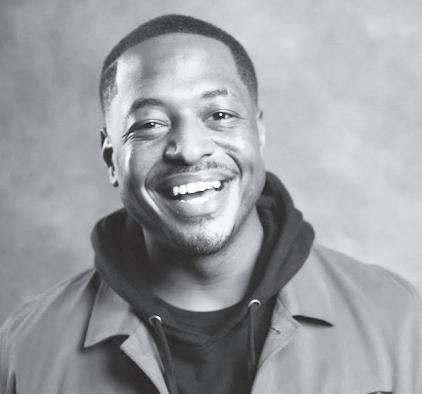
have a Clark’s sub, or that ice cream from Majestic Drug, you can come to Hallie,” Roberts said. “If you want to have something from the Booker Family Cookbook, you can come to Hallie. Not only are you eating physical food, you’re literally communing with your elders. You’re literally communing with your ancestors.”
Roberts emphasized that Hallie Q. Brown’s future de-
“If there’s one place you can live forever, it’s the place that holds your story. And that’s Hallie.”
son-Brown stepped down citing misaligned priorities with city officials, fueling ongoing concerns about how violence prevention efforts are being managed.
Abdul-Ahad supports shifting oversight responsibilities from NSD to Hennepin County. “They have the personnel, they have the management structure there that could oversee the work and, you know, give us project managers,” Abdul-Ahad said.
“They have the infrastructure to be able to give it the oversight that it needs. Okay, right now, the city doesn’t have that. We don’t even have a project manager.”
NSD Deputy Director Lea Lakes did not respond to email requests for comment at this time.
Criticism over vendor selection
Critics of the program have also raised concerns about vendors like A Mother’s Love
and We Push for Peace. Some accuse these groups of disrupting protests and engaging in violent behavior. Communities United Against Police Brutality (CUAPB) highlighted incidents where operatives were involved in physical altercations at protests and mishandled protest materials.
“The cost of training for these groups is excessive, and there is no clear evidence that these programs are working,” Michelle Gross, executive director of CUAPB, wrote in a letter to the council. “We urge the council to reconsider these contracts and demand transparency on the effectiveness of the violence interrupters.”
Despite these criticisms, supporters of the Cure Violence Global model argue that such programs are essential for reducing violence in communities where law enforcement is
For more information on becoming a mentor, visit www. bigstwincities.org.
Kiara Williams welcomes reader responses at kwilliams@ spokesman-recorder.com.
“That’s how we make an impact — through education, awareness, and community involvement.”
pends on collective action.
“Generosity is our signature,” he said. “And we won’t live just because Hallie’s thriving, but because we’re helping other organizations in this community thrive as well.”
As the event concluded, he urged attendees to support the expansion efforts through donations, advocacy, or just spreading the word.
“If we can crack this, we’ll have something scalable that can help support longevity in our community,” Roberts said.
With 96 years behind it, the Hallie Q. Brown Community Center remains a beacon of resilience, history and hope. As it moves toward its centennial, its leaders and community members are determined to ensure that Rondo’s legacy — and its people — continue to thrive for generations to come.
Aria Binns-Zager welcomes reader responses at abinns@ spokesman-recorder.com.
often seen as untrustworthy.
What comes next?
As part of the oversight for the initiative, a comprehensive evaluation of the program’s vendors and their effectiveness will be conducted, with the first month’s data set to be released on May 8. An online dashboard will provide six months of data to the public. The findings could influence future funding decisions and determine whether the current model remains viable.
With concerns about staffing shortages, contract transparency, and gaps in coverage — particularly in Zone 2 — community advocates and city officials will be watching closely to see if these investments yield measurable reductions in violence.
Clint Combs welcomes reader responses at ccombs@spokesman-recorder.com.

‘It’s
By Jasmine McBride Associate Editor
This year’s Minnesota Jazz Legends event, hosted at the Minnesota History Center on Sunday, April 13, from 2 to 4 pm, offers more than just music — it’s a deeply intentional celebration of legacy, memory and sound. Set during National Jazz Appreciation Month and presented in partnership with Jazz88, the Minnesota History Center, and the Minnesota Arts and Cultural Heritage Fund, the event honors four titans of the Twin Cities jazz scene: drummer Jay Epstein, pianist and Walker West co-founder Grant West, Dixieland trombonist Art Katzman, and the late vocalist Debbie Duncan.
Each year the honorees are carefully selected for their musical impact and dedication to the art form. This year’s lineup reflects the diversity within jazz itself:
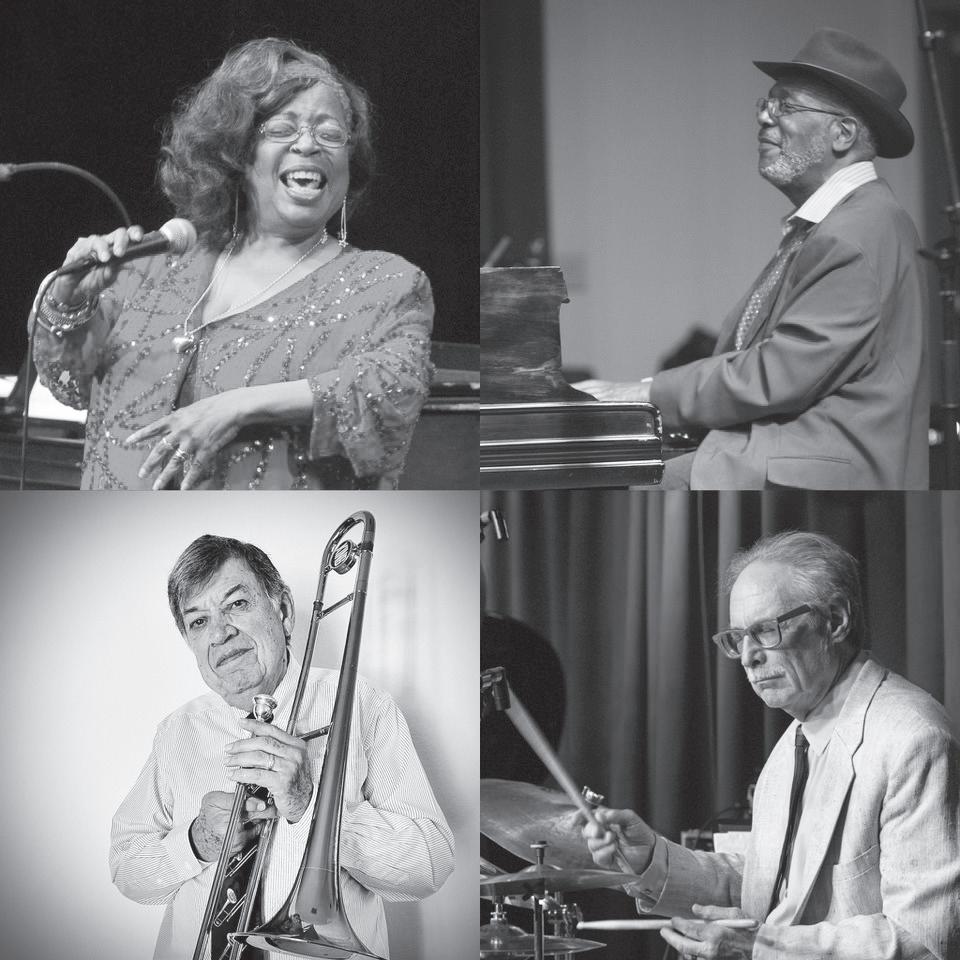

scene — backing national acts, saying no to fame in favor of artistry, and still playing with passion.”
• Jay Epstein, a drummer whose journey began with an early ‘aha’ moment, will share his story and perform live.
• Grant West, co-founder of St. Paul’s Walker West Music Academy, will reflect on his personal history and the legacy of building an institution rooted in community and jazz
education.
• Art Katzman, a Dixieland trombonist and longtime member of the Barbary Coast Dixieland Band, will bring a touch of New Orleans sound and humor to the stage.
• Debbie Duncan, the beloved vocalist who passed away in 2020, will be honored through video, testimony, and a celebration of her powerful, genre-crossing voice.
“Debbie was Ella Fitzgerald personified,” said Patty Peterson. “She could switch to the blues or pop with such ease. She’s missed terribly. Honoring her is incredibly personal for me.”
Peterson, an award-winning jazz vocalist and radio host with Jazz88, knows firsthand how rich Minnesota’s jazz history is — and how fragile. “I come from a musical family known originally as the ‘First Family of Jazz,’” she explained.
“We were raised on show
tunes and jazz standards — Gershwin, Cole Porter, Basie. That was the music of our household. But we’ve also played everything from jazz fusion to country. Jazz is what we cut our teeth on.”
At the event, backing the honorees will be the Phil Aaron Trio, featuring Graydon Peterson on bass and Phil Hey on drums, all of whom have deep roots in the Minnesota jazz scene.
“Why should people come to this event?” Peterson said during a recent interview. “Because it’s not just music. It’s a story. It’s preservation. And it’s heart.”
Asked how she defines a “legend,” Peterson didn’t hesitate: “A legend is someone who has made a life choice to play music, even when it meant simplifying their life to stay true to their art,” she said. “It’s someone who’s been the cream of the crop in our local



Anita Alexander
Torrion Amie
Holly Andersen
Richard Anderson
Nancy L. Beals
Jonathan Beck
Clara Boykin & Family
Gretchen Bratvold
Amanda Brinkman
Toweya Brown-Ochs
Benjamin F. Bryant
& Dr. Antusa S. Bryant
Deanna Callender
Shirlee L. Callender
Karl Cambronne
Flo Castner
Liam Cavin
Janis Clay
Edward Coblentz
Coventry Cowens
Alvin E. Cunningham
Michael Davis
Victoria Davis
Marie Denholm
Michael Diehl
April A. Estes
George Ewing
Elizabeth Fealey
David Fettig
Readus Fletcher
Ken Foxworth
Michael Franks
Lee Friedman
Ella Gates-Mahmoud
Kimerlie Geraci
Erick Goodlow
Leota Goodney
Walter Greason
Karlene Green
Pamela Hall-Clemens
Charles Hallman
Jeana Hamm
Hendon Group, Inc
Thomas Hill
Maxine & Kieran
Hughes
Ellen Guettler & Ben Pofahl
The idea for Minnesota Jazz Legends was born in 2011 when Peterson witnessed a performance featuring Irv Williams, Percy Hughes, Cliff Brunzell, and her mother, Jeanne Arland Peterson — all in their nineties. “I remember sitting there thinking, ‘Why is no one documenting this?’” That moment lit a spark. By

Colnese Hendon
Connie Hudson
Angelo Hughes
Andrew Issacson
Katie Izzo
Ms. Jewelean Jackson & Sir Steven C. Davis
Nina Johnson
Clarence Jones
Debra Jones
Shirley R. Jones
Julie July
Cynthia Kelly & Murry Kelly Jr.
Nathaniel Khaliq
Zena Kocher
Jimmy Lewis
Lisa Lissimore
Michele Livingston
Harlan Luxenberg
MRPP and Associate Communications
Melanie Manaen
Rose McGee
Peter McLaughlin
Jeffrey McVay
Kyle Meerkins
Deborah Montgomery
2013, the idea had blossomed into a collaboration with the Minnesota History Center and Jazz88, supported by a grant from the Minnesota Arts and Cultural Heritage Fund.
Now, in its 11th year (with time off during Covid), Minnesota Jazz Legends has become a cornerstone event for the jazz community — blending live performances, intimate storytelling, and historical preservation into a single afternoon.
Christian Peterson, public program associate of the Minnesota Historical Society, emphasized how seamlessly the event aligns with their mission. “We’re here to serve all the people of Minnesota and create a powerful engagement with history,” he said. “What Patty’s doing brings history alive in such a dynamic way. You’re not just reading about it — you’re in the room with it.”
While the event celebrates the past, it also invites younger audiences into the fold. “I’ve noticed a gap between generations when it comes to jazz,”
I shared during the interview.
“But I’ve also seen younger folks showing up at places like
Debbie Morrison
Marcia Murray
Mary K. Murray Boyd
Dan Ness
Sanda Noy
Amethyst O’Connell
The O’Neill Family
Minister Dr. Ni Ora Hokes
Liz Oppenheimer & Jeanne Burns
Tamara Pollard
Fiona Pradhan
Ray Seville Productions
Mary Quinn McCallum
Dr. Mitchell Palmer McDonald
Heidi Pemberton
Amy Pfankuch
Patty Ploetz
Catherine Pruszynski
Mark Ritchie
Lyn Rabinovitch & John Saxhaug
Augustus Ritemon
Carolyn Roberson
Winthrop & Barbara
Rockwell
M. Rebecca Ross
The Dakota. I think showing up to events like this actively helps shift the narrative that jazz is only for older audiences.” Patty agreed. “Jazz morphs. It’s not stuck in the past. Blues can be jazz, fusion can be jazz, funk can be jazz. It’s expressive. It’s alive.”
And with venues like the Dakota, Crooners, Jazz Central, and even the legacy of the now-closed Artists’ Quarter, the Twin Cities remain fertile ground for live jazz.
This year’s Minnesota Jazz Legends is more than a concert — it’s a communal memory, a documentary in real time, and a love letter to Minnesota’s jazz roots. Attendees will laugh, cry, sing along, and, more than anything, walk away with a renewed sense of appreciation for the artistry that continues to shape the state’s cultural rhythm.
To learn more or stream past Jazz Legends radio specials, visit Jazz88.fm or search “Minnesota Jazz Legends” online.
Jasmine McBride welcomes reader responses at jmcbride@ spokesman-recorder.com.
St. Paul Saints
Anura Si-Asar
Floyd Smaller
Chanda Smith Baker
South Hill Film
Ronald Spika
Stan Sandiford
Cyriaque Sukam
Timothy Sullivan
Heidi Swank
Gregory Tillman
Dotty Timmons
Nicholas Upton
Kelsi Ustipak
Donald Walker
Jason Walker
Dr. Betty Webb
Bill Wells
Tracy Wesley
Gary & Kathy Wilde
Jeffery Young
By Kiara Williams Staff Writer
Historically Black Greek Letter Organizations (BGLOs) have long been pillars of scholarship, service and activism within the Black community. Founded in response to racial exclusion on predominantly white campuses, these organizations provided Black students with a sense of belonging and a foundation for leadership, academic excellence, and community empowerment.
Since their inception in the early 20th Century, BGLOs have significantly shaped the African American experience, contributing to the Civil Rights Movement with leaders like Martin Luther King Jr., W.E.B. Du Bois, Thurgood Marshall, Shirley Chisholm, Rosa Parks, Maya Angelou and Barack Obama.
The “Divine Nine”
The National Pan-Hellenic Council (NPHC), or “Divine Nine,” is a coalition of nine historically Black Greek letter fraternities and sororities. These organizations were created to provide leadership, support and advocacy during a time of exclusion and segregation on college campuses.
The first BGLO, Alpha Phi Alpha Fraternity, Inc., was

founded in 1906 at Cornell University to foster scholarship and brotherhood among Black students. Alpha Kappa Alpha Sorority, Inc. was established at Howard University in 1908, followed by Kappa Alpha Psi Fraternity, Inc. (1911), Omega Psi Phi Fraternity, Inc. (1911), Delta Sigma Theta Sorority, Inc. (1913), Phi Beta Sigma Fraternity, Inc. (1914), Zeta Phi Beta Sorority, Inc. (1920), Sigma Gamma Rho Sorority,
Inc. (1922), and Iota Phi Theta Fraternity, Inc. (1963).
Each organization has played a role in uplifting the Black community by creating spaces for students to network, develop leadership skills, and advocate for social justice.
A Black Greek refers to a member of one of the Divine Nine, distinguished by their emphasis on leadership, scholarship, service, and community involvement. Members uphold

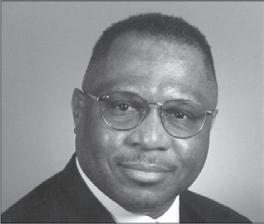

a longstanding tradition that connects them to a broader legacy of activism and service within the African American community.
Sharhonda Chea, a member of Zeta Phi Beta Sorority, Inc., explains, “We were founded out of necessity. Our organizations were created to uplift, to educate, and to provide resources for our communities when access was extremely limited.”
Josephine Myers-Kuykindall, a member of Alpha Kappa Alpha Sorority, Inc., adds, “There’s prestige, obviously. Presidential candidate Kamala Harris is a member of Alpha Kappa Alpha. But most importantly, we do it from a service mindset.
“We were founded out of necessity.”
That’s really important to me, along with sisterhood and friendship. We don’t have a lot of that in the African American community, so I work with young women because mentorship is key.”
BGLOs require a lifelong commitment, with members continuing to serve their communities and lead in various sectors after graduation. The focus on mentorship and leadership develop
ment is a key aspect of this investment, alongside the core values of brotherhood and sisterhood.
Jeffrey Keels, president of the Zeta Nu Sigma Alumni Chapter of Phi Beta Sigma Fraternity, Inc., notes, “The leadership side of these organizations really takes shape after college. The post-graduate experience, with its business networking and mentorship, is vital to our members’ success. But the brotherhood is something that keeps us grounded — it’s a constant, no matter where you are in life.”
Chea highlights the lifelong nature of BGLO membership, stating, “Zeta Phi Beta Sorority is a lifetime commitment. We stay engaged in the community, ensuring that we’re creating opportunities for those

Myers-Kuykindall echoes this sentiment: “All of these organizations are about building initiatives to close the gaps in our communities. We’re not waiting for someone else to do it. We’re taking action and making change.”
Keels acknowledges that some of today’s youth question the Divine Nine’s relevance. “This generation is different — not in a bad way. They focus on careers, stability, and their future.”
who come after us.”
Despite their rich history, BGLOs are often misunderstood. Many associate these organizations with partying and hazing, overlooking their core values. Chea clarifies, “People think we’re just about stepping, strolling, and social events. While those are important aspects of our culture, our organizations are grounded in scholarship, service and activism. We create programs that support families, uplift communities, and educate our youth.”
Keels adds, “Greek life is different down South than in Minneapolis. Where I grew up, Black Greek organizations were central to our identity and pride. But even outside of the South, the legacy of these organizations remains strong.”
Looking to the future, BGLOs remain committed to service, leadership and activism. Chea believes these organizations will continue to shape the next generation of leaders. “Our purpose is still the same: to serve, uplift, and lead,” she says. “We are committed to creating a better future for the next generation.”
So the question arises: Are these organizations still needed? While young people may not face the same struggles as their predecessors, they remain engaged in activism, mentorship and service — often through careers and personal initiatives rather than a BGLO membership. In northern regions, limited exposure may also be a cause of reduced interest.
Yet, the fight for equity, justice and representation persists. Keels states, “Discrimination and injustice are still very real. Our initiatives benefit the next generation, whether they realize it or not.”
The challenge now is communicating the relevance of these organizations in a world where many young Black professionals already embody BGLO values in their daily lives. BGLOs remain crucial to maintaining a collective commitment to Black excellence and empowerment by providing structured mentorship, leadership development, and community service opportunities.
Kiara Williams welcomes reader responses at kwilliams@ spokesman-recorder.com.
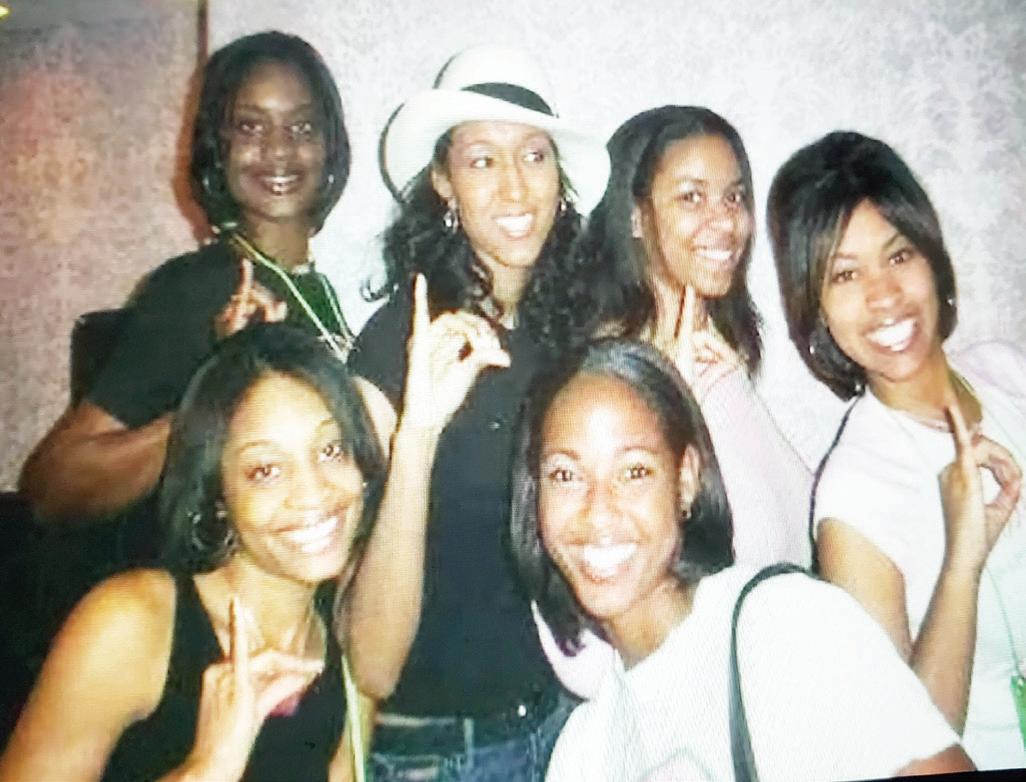

By Jaiden Leary
Bipartisanship is rare in Minnesota’s legislature, but both parties agree on increasing teachers of color. Research consistently shows that these educators benefit all students, not just students of color. Yet, despite millions allocated to this goal, their numbers have barely increased.
program could reward schools that maintain at least a 10% margin between their teachers of color ratio and their students of color ratio. This funding, tied to retention, could also discourage layoffs that disproportionately affect teachers of color. Additionally, it would direct resources to urban schools, where most students of color are enrolled.
By Laura Onyeneho
Spring is here, and that means it’s time for spring cleaning! But while most people think of scrubbing floors, donating old clothes, and decluttering their homes, your social circle is another area often overlooked.
Just as a messy, disorganized living space can weigh you down, so can unhealthy friendships. It’s time to assess the company you keep and determine who truly belongs in your life.
As we grow older, we begin to realize that friendship isn’t about the number of people we surround ourselves with, but about the quality of those relationships. A large group of friends might seem fulfilling, but if those friendships aren’t built on mutual respect, trust and support, they can drain more energy than they provide.
Toxic relationships can be just as harmful to your wellbeing as an unclean, cluttered home. Studies have shown that negative relationships increase stress, impact mental health, and even weaken the immune system.
Identifying toxic relationships
Not all friendships are meant to last forever, and that’s okay. But it’s important to recognize when a friendship has run its course. Here are some signs I’ve learned over time that a friend may no longer be a positive influence in your life:
• They don’t support you. True friends celebrate your successes and offer encouragement during tough times.
If someone constantly downplays your achievements or makes you feel small, they’re not in your corner.
• They bring more stress than joy. Friendships should uplift and energize you, not leave you feeling drained. If you dread interactions with a friend, it’s a sign that something isn’t right.
• It’s always about them. Relationships should be a two-way street. If a friend only comes to you when they need something but never reciprocates, it might be time to reevaluate their place in your life.
• They don’t respect your boundaries. A good friend understands and respects your limits.
step back and reflect: Does this friendship add value to my life?
Even high-profile celebrities have gone through friendship fallouts that remind us of the importance of reassessing relationships. Jay-Z and Kanye West were once inseparable, but their friendship soured as their personal and professional goals diverged.
Kim Kardashian and Angela White (formerly Blac Chyna) also distanced themselves after realizing their irreconcilable differences. These examples show that outgrowing friendships isn’t just a personal experience — it happens on every level, including in the spotlight.
How to refresh your social circle
Once you’ve recognized which friendships may not serve you anymore, what’s next? Here are a few steps to take:
• Focus on those who uplift you. Strengthen the friendships that bring you joy, motivation and encouragement.
• Seek new connections. Be open to meeting new people who align with your current values and goals.
In 2023, the Increase Teachers of Color Act (ITCA) passed as part of the Education Omnibus Bill. It was the seventh such initiative since 2017, yet progress remains minimal. According to the Professional Educator Licensing and Standards Board (PELSB), teachers of color made up just 5% of the workforce in 2018-2019, rising to only 5.9% by 2024 — far short of the state’s goal of a 2% annual increase.
Reflecting on my own education, I can attest to the impact of teachers of color. One encouraged me to take an advanced science class. Another inspired my interest in politics. Their influence shaped my academic and career choices. While necessary representation of teachers of color remains underserved, here are a few tangible solutions that I think would lead to improvement in the state of Minnesota:
Solution 1: Financial incentives
A financial approach could motivate districts. A grant
Solution 2: Paying student teachers
Student teaching is a crucial step toward becoming a teacher in Minnesota, yet it requires 12 or more weeks of unpaid work. Many aspiring educators must take out loans just to complete this requirement. While Minnesota Student Teacher Grants exist, they often fall short. Paying student teachers would remove a major financial barrier and encourage more teachers of color to enter the profession.
Call to action
The psychology of a friendship cleanse I read an interesting article in “Psychology Today” titled “Why You Should Do a Friends Cleanse Periodically. The author discusses the importance of consciously assessing your friendships. They point out that unless we actively take stock of our relationships, it’s easy to fall into a routine of keeping people around simply out of habit. A periodic friends cleanse forces you to

submissions@spokesman-recorder.com
submissions@spokesman-recorder.com
ads@spokesman-recorder.com
submissions@spokesman-recorder.com.
• Set boundaries. If you choose to keep certain friendships but recognize their limitations, establish clear boundaries to protect your well-being.
• Let go with grace. Not all friendships end in conflict. Sometimes, simply stepping back and allowing distance to grow is the healthiest choice.
Originally posted on The Defender. For more information, visit defendernetwork.com.
Reflecting on my own education, I can attest to the impact of teachers of color.
Solution
Minnesota has taken steps to address this issue, but more must be done. Structural barriers continue to drive teachers of color away from the profession. If the state is serious about diversity in education, it must implement policies that make entering and staying in the profession viable. Teachers of color are crucial to a better-educated and more equitable Minnesota. Addressing these challenges effectively could make the state a national leader in education reform.
Jaiden Leary is a senior at Saint Louis Park High School and has researched this issue extensively.
Minnesota has made strides in reducing college costs, such as the North Star Promise, which offers free tuition to families earning under $80,000. However, student debt still discourages potential teachers of color. Research shows they carry higher debt than their white peers, making loan forgiveness an essential tool for recruitment and retention. Beyond tuition, aspiring teachers face financial burdens related to housing, transportation, and basic necessities. Evidence from other fields demonstrates that scholarships and loan forgiveness programs effectively recruit professionals to underserved areas. Service scholarships, which reduce tuition costs upfront, may be more effective than loan forgiveness in influencing career choices.
‘We are not going back’ Black Press and Black Church target Target
By Benjamin F. Chavis Jr.
For over 198 years the Black Press and the Black Church have joined together for causes of freedom, justice, equality, equity, and empowerment. Today more than ever before there is renewed urgency for the Black Church and the Black Press to publicly amplify our mutual interests to protect and maintain the hard-fought gains and progress that have been accomplished by African Americans in the last two centuries.
On the record, “We are not going back in America and nowhere else in the world in 2025.” We have already suffered too much from the vicious unprecedented genocide, terrorism, and crimes against humanity during the Transatlantic Slave
Trade, global imperialism, racism, colonialism, neocolonialism, reconstruction and Jim Crow, mass incarceration, and present day repressive policies and Executives Orders in an attempt to erase our history and legacy with libelous actions and falsehoods.
The prophetic voice of the Black Church continues to resonate with historic and contemporary inspiration and power. Together we are resolutely demanding respect from Target and those companies that make billions of dollars from our consumership.
We are not begging. We are demanding respect and an equitable business relationship with Target and corporate America.
From executive decision makers to marketing and promotions account managers, to human resources directors, and to the
shareholders of the companies, we demand economic restoration and respect.
We salute the bold leadership of The Reverend Jamal Harrison Bryant and the New Birth Missionary Baptist Church in Atlanta and other Black Church leaders across the nation who are standing up and preaching liberation theology. TARGET will continue to be our target. We in the Black Press of America will continue our public education and selective buying campaign. No respect, no buying. No justice, no peace. May God continue to bless the Black Church and the Black Press.
Rev. Dr. Benjamin F. Chavis, Jr. is president and CEO of the National Newspaper Publishers Association and BlackPressUSA.
By Martin Sostre
Sisters and Brothers:
The escalating repression by this predatory, racist and sexist capitalist system makes glaringly clear to all but the most politically backward that the dire predictions that U.S. capitalism would evolve into fascism have come to pass.
Restoration of the death penalty, life sentences for drugs, recent Supreme Court rulings upholding the denial of the right to live in communes, the right to privacy and human dignity (by granting police the right to arbitrarily invade peoples’ persons and homes and use as evidence in court anything seized during the illegal search), police electronic eavesdropping, infiltration, frame-ups, assassinations, brutalisations, de-humanisa-
tions, behaviour modification, and genocide are some of the repressive fascist measures now being implemented.
The question now is: What are we going to do about this murderous fascism? Shall we continue spouting revolutionary rhetoric without commensurate deeds and passively stand by like sheep while our comrades are framed by the gestapo police kidnapped off the streets and murdered one by one? Must we passively wait our turn to be led to the oppressors’ cages, brutalised or murdered?
Or shall we oppose the choking fascist oppression which if allowed to continue encroaching on what is left of our personal freedoms will eventually convert us into de-humanised mindless robots? The answer is
obvious. Indeed, to defend ourselves by all means necessary against the destruction of our human rights and personhood not only is the natural right to self-defence, but a human duty. By what means then shall we resist the fascist oppressors? The answer to this is determined by the means employed to press us. Our oppression is multi-dimensional. We are oppressed economically, legally, psychologically, culturally, physically and by all other means deemed necessary by the criminal ruling class to maintain themselves in power. Since oppression is multidimensional, does not common sense dictate that resistance to it be multi-dimensional with each level of oppression challenged by a commensurate level of revolutionary resistance?
For example, the fascist lies propagated by the controlled media press must be challenged with revolutionary truth disseminated by the movement press, tapes, films, books, pamphlets, leaflets, posters, etc. Not too many revolutionaries and militants will disagree with this. Only when the same common sense is applied to opposing fascist violence with revolutionary armed resistance do many of them become horrified. Witness the reaction of most of the movement people to SLA’s [Symbionese Liberation Army] revolutionary response to fascist repression.
This is a portion of revolutionary political prisoner Martin Sostre’s “Armed Struggle: Natural Response to Fascism.” To read the full essay, visit blackagendareport.com.
From Ads Department/MN Spokesman-Recorder
Metro Social Services, Inc. seeks a Business Operations Analyst to work at its St. Paul, MN location to evaluate policies, procedures & functions using statistical analysis, address business issues, write memos & develop business practices. Bachelor’s in business operations, administration or a related field & 3 years’ experience required. Submit resume to Sunday Olayinka, Director of Operations, 345 University Ave W, St. Paul, MN 55103, or at solayinka@metrosocialservices.org or visit https://www. metrosocialservices.org/
PLEASE CONTACT
Land O’Lakes, Inc. dba Land O’Lakes, Arden Hills. MN.
Req. Master’s Deg. in Supply Chain Management & Analytics, Agriculture, Applied Sciences, or rel. field & 5 years of exp. as a Supply Chain Analyst, Business Analyst, Project/Program Manager, Technology Consultant, or related occupation in agriculture technology OR Bach. Deg. in Supply Chain Management & Analytics, Agriculture, Applied Sciences, or a rel. field & 7 years of exp. as a Supply Chain Analyst, Business Analyst, Project/Program Manager, Technology Consultant, or related occupation in agriculture technology. Req. 7 years of experience with Bach. Deg or 5 years of exp with Master’s Deg. in the following: SDLC, solutions design, & delivery of enterprise-level solutions using Agile/ Scrum methodology; Utilization & application of database management & data flow; Working in agriculture industry with carbon-specific data, related analysis, testing, validation, & reporting; and understanding of data standards for agriculture supply chain & sustainable agriculture. Req. 5 years of exp in the following: Working within the carbon credit market, registration body standards (CAR, Verra, SBTi, GHG Protocol), & technical modeling solutions; Product knowledge of supply chain traceability & GHG accounting; Working on corporate social responsibility reporting & global sustainability reporting; Working with third-party providers enabling platform data integrations; and Azure DevOps. 5% national travel on a quarterly basis for meetings & events (industry conferences, customer meetings/events, workshop planning meetings). Position open to telecommuting from anywhere in the US. Salary: $214,074.00 to $219,095.00 per year. For confidential consideration, please submit résumé to https://careers.landolakesinc. com using requisition R-34722. No agencies or phone calls please.
Minnesota Spokesman-Recorder April 10, 2025
VIEW Continued from page 10
it,” said Niamya Holloway
“This is something that has given them tremendous joy and that they work very hard for. Seeing them at the heights of this achievement is a wonderful thing,” said U of M Senior Associate AD Peyton N. Owens III
Gopher Assistant Coach Ariel Braker: “I’m just really excited and happy for them.”
“I’m just really excited and happy for them.”
Gopher Assistant Coach
Aaron Horn: “It was a long season because it started off with Mara Braun going down and Taylor Woodson going down… It was so good to finally get the championship.”
The Women’s Basketball Invitation Tournament (WBIT) finished its second year as a 32-team postseason tournament operated and funded by the NCAA. It is seen behind the larger NCAA tournament, the second-best women’s basketball postseason tournament.
“It’s kind of a fun moment for our team and for our program,” stressed Plitzuweit.
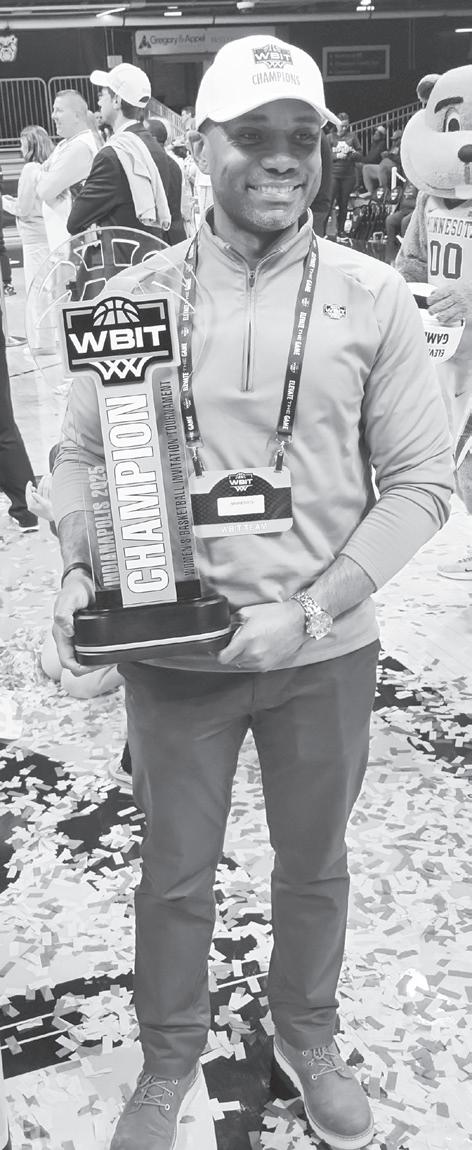
Senior Associate AD
Finally… Sixteen Black coaches led teams in this year’s women’s NCAAs, up from nine in 2019, including Dawn Staley, who led South Carolina to its second consecutive championship game on Sunday. Houston’s Kelvin Sampson was the only Black coach in this year’s men’s Final Four — he coached in Monday’s championship game.
Charles Hallman welcomes reader comments to challman@ spokesman-recorder.com.
ACCOUNTING DEPT @ BILLING@SPOKESMAN-RECORDER.COM
Minnesota Spokesman-Recorder April 3, 10, 2025
ASSUMED NAME FLAT RATE: $215
Metro Social Services, Inc. seeks a Computer Systems Architect to work at its St. Paul, MN location to understand the systems governing Metro’s operations, assess systems infrastructure, identify needed updates & upgrades, streamline systems architecture, assess & address risk, plan for contingencies, monitor project progress & ensure industry & regulatory compliance. Bachelor’s degree in computer science & 3 years’ experience required. Submit resume to Sunday Olayinka, Director of Operations, 345 University Ave W, St. Paul, MN 55103, or at solayinka@metrosocialservices.org or visit https://www. metrosocialservices.org/
SIZE: 2 COL
Minnesota Spokesman-Recorder April 3, 10, 2025
2 WEEK RUN
Metro Social Services, Inc. seeks a Community Health Program Coordinator to work at its St. Paul, MN location to assess client health needs, develop strategies to improve client & community health, collect & analyze health data, prepare & distribute educational materials & lead awareness & education initiatives. Bachelor’s in health science or related field & 3 years’ experience required. Submit resume to Sunday Olayinka, Director of Operations, 345 University Ave W, St. Paul, MN 55103, or at solayinka@metrosocialservices.org or visit https://www. metrosocialservices.org/
Please Note: New email address for all future ads is ads@spokesman-recorder.com
The MSR handles billing digitally. This means you will get e-tears and e-mailed invoices unless you specifically request a hard copy.
Minnesota Spokesman-Recorder April 3, 10, 2025
From Ads Department/MN Spokesman-Recorder
Phone: 612-827-4021
Metro Social Services, Inc. seeks a Community Counseling & Social Services Program Manager to work at its St. Paul, MN location to oversee its community counseling & social services programs, manage staff caseloads, intakes & assessments, assist with ethical & regulatory compliance & align services with organizational & stakeholder missions. Bachelor’s in guidance, counseling or related field & 3 years’ experience required. Submit resume to Sunday Olayinka, Director of Operations, 345 University Ave W, St. Paul, MN 55103, or at solayinka@metrosocialservices. org or visit https://www.metrosocialservices.org/
FOR BILLING
INQUIRIES & TEARSHEETS
PLEASE CONTACT
ACCOUNTING DEPT
BILLING@SPOKESMAN-RECRDER.COM
EMPLOYMENT DISPLAY
SIZE: 2COL X 6 INCH
Minnesota Spokesman-Recorder April 3, 10, 2025
RATE: $44.60 PER COL. INCH
TOTAL: $535.20
Sr. Risk Management Specialist: Medtronic, Inc., Fridley, MN
Please proof, respond with email comfirmation to ads@spokesman-recorder.com
Duties: Responsible for ensuring the safety of finished medical devices throughout the product lifecycle. *Multiple positions available. Salary: $120,200 to $152,400. To apply, visit https:// medtronic.wd1.myworkdayjobs.com/MedtronicCareers/, select Req. R25800. No agencies or phone calls please. Medtronic is an equal opportunity employer committed to cultural diversity in the workplace. All individuals are encouraged to apply.
The MSR handles billing digitally. This means you will get e-tears and emailed invoices unless you specifically request a hard copy.
Minnesota Spokesman-Recorder April 10, 2025
Continued from page 10
not that’s true, Johnson truly deserves a shot at making a W roster this summer.
The Philadelphia native won this year’s MEAC Player of the Year, made first team all MEAC, and was listed on many best-guard-in-the-nation award watch lists. She plays much taller than her listed height.
At the MEAC post-season tournament, Johnson simply told me that she just wants a true opportunity to make a pro team.
Her college career was a well-traveled one—first at Rutgers (2020-21), then North Carolina State (2021-23) be-
fore finally finding a home at Norfolk State in 2023. All Big Ten freshman, all conference second team at her first school; second team all-ACC (2023) and Sixth Player of the Year (2022) at her second school. Then at Norfolk State for her final two seasons, Johnson was 2024 MEAC Tournament MVP and this season makes the AllMEAC defensive team.
Johnson last Saturday was named MVP of the Women’s College All-Star Game with 21 points, four rebounds and two steals.
“It’s not ideal for players to come from PWIs twice,” said Johnson to The Next’s Rob Knox in February. “I love every second of it [being at NSU]. It is probably one of the best decisions I have ever made.”
Metro Social Services, Inc. seeks a Medical Services Coordinator to work at its St. Paul, MN location to manage community outreach events, refer clients to for assistance, identify & address barriers to care & schedule client visits. Bachelor’s in health science or related field & 3 years’ experience required. Submit resume to Sunday Olayinka, Director of Operations, 345 University Ave W, St. Paul, MN 55103, or at solayinka@metrosocialservices.org or visit https://www.metrosocialservices.org/
Minnesota Spokesman-Recorder April 3, 10, 2025
Metro Social Services, Inc. seeks a Computer Systems Administrator to work at its St. Paul, MN location to maintain Metro’s computer networks, improve performance and security, evaluate vulnerabilities, create data redundancies, resolve network & software issues & provide software support, installation, integration & compatibility. Bachelor’s in computer science & 3 years’ experience required. Submit resume to Sunday Olayinka, Director of Operations, 345 University Ave W, St. Paul, MN 55103, or at solayinka@metrosocialservices.org or visit https://www.metrosocialservices.org/
Minnesota Spokesman-Recorder April 3, 10, 2025
Senior Reliability Engineer: Medtronic, Inc., Minneapolis, MN
Req. Masters’ Degree or foreign equiv.in Mechanical, Industrial, Chemical or Biomedical Eng. or rel. eng. fld & 2 yrs. exp. as a quality or reliability eng. or rel. occ.; or a Bachelors’ Degree or foreign equiv.in Mechanical, Industrial, Chemical or Biomedical Eng. or rel. eng. fld & 5 yrs. of exp. as a quality or reliability eng. or rel. occ. Position permits telecommuting from anywhere in the US. Apply at https://medtronic.wd1.myworkdayjobs.com/ MedtronicCareers, Req. #R25491. No agencies or phone calls. Medtronic is an equal opportunity employer committed to cultural diversity in the workplace. All individuals are encouraged to apply. Minnesota Spokesman-Recorder April 10, 2025 From Ads Department/MN Spokesman-Recorder
Phone: 612-827-4021 FOR BILLING INQUIRIES & TEARSHEETS PLEASE CONTACT ACCOUNTING DEPT
BILLING@SPOKESMAN-RECRDER.COM

Multiple transfers, especially in this era of the transfer portal, shouldn’t be held against Johnson for leaving two Power 4 schools for an HBCU. Johnson’s career stats — 19.4 ppg, 5.8 rebounds — and starting
The MSR handles billing digitally. This means you will get e-tears and emailed invoices unless you specifically request a hard copy.
57 of 58 college games proves that she can play in whatever uniform she wears.
Charles Hallman welcomes reader comments to challman@ spokesman-recorder.com.
in a released statement.
Big Ten squads against each other.
WNBA hiring Black coaches
It hasn’t been reported much, but WNBA teams over the off season have been hiring Black assistant coaches. Chicago has an all-Black coaching staff, including HC Tyler Marsh, and 12 Black assistant coaches also have been hired for this season.
HBCU Athletic Conference grows HBCU Athletic Conference (HBCUAC) last week welcomed Paul Quinn College and Huston-Tillotson University as new conference members, effective July 1. This brings the total membership of the only all-HBCU conference in the NAIA to 15 schools.
“We are thrilled to welcome Huston-Tillotson University and Paul Quinn College to the HBCU Athletic Conference,” said Commissioner Dr. Kiki Baker Barnes
“Both institutions bring a rich tradition of athletic and academic excellence, and their addition strengthens our conference’s mission to elevate HBCU athletics while creating more opportunities for student-athletes to compete at the highest levels.”
Also announced last week: The HBCUAC becomes the only HBCU conference to offer a men’s soccer championship.
The two new schools “paves the way for the addition of men’s and women’s soccer as
official HBCUAC championship sports,” noted the league’s press release. Huston-Tillotson is located in Austin, Texas, and was established in 1875 as Austin’s first institution of higher learning. Paul Quinn is located in Dallas, Texas, was founded in 1872 in Austin, then moved to Dallas in 1990. Both schools were members of the Red River Athletic Conference.
Charles Hallman welcomes reader comments to challman@ spokesman-recorder.com

NDIANAPOLIS — Minneso-
ta is the second Big Ten team to win the WBIT Women’s Championship in consecutive years (Illinois won last year).
The Gophers defeated Belmont 75-63 last Wednesday night at Hinkle Fieldhouse.
Freshman Tori McKinney had a career-high 26 points and three steals to lead Minnesota (25-11). She was named WBIT Tournament MVP and made All-Tournament alongside teammate Amaya Battle, who had 17 points, seven rebounds and five assists.
“That was crazy,” McKinney told the MSR, the only Minnesota media in attendance at the title game. On her honors, “My teammates made it all possible,” she said.
As a result, we successfully captured first-person comments before and after the game – here are some excerpts
By Charles Hallman Sports Columnist
he 2025 WNBA Draft is set for Monday, April 14.
Dee Dee Hagemann and Diamond Johnson are hoping their names are called at some point of the three-round draft.
Strength training for the pros
Dee Dee Hagemann, a 5’7” guard and Detroit native, first starred for three seasons at Michigan State before transferring to Memphis for her senior season. As a senior, she averaged six assists a game, 11th best in the nation in 35 minutes per contest.
At State, Hagemann made the Big Ten second team in 2023-24, a two-time All-Big Ten honorable mention, all-conference freshman after a stellar prep career in the Motor City, where she was named both Michigan Miss Basketball and Michigan Player of the Year in her senior year (2021).
Next week, the four-year college guard looks to move forward in her hoopin career, be-

from before the game. Terrell Battle, Amaya Battle’s father: “Is it the NCAA tournament? No! But they’re still playing.”
Nolana Holloway, Niamya Holloway’s mother: “I’m excited every time the Gophers get the opportunity to be able to compete.”
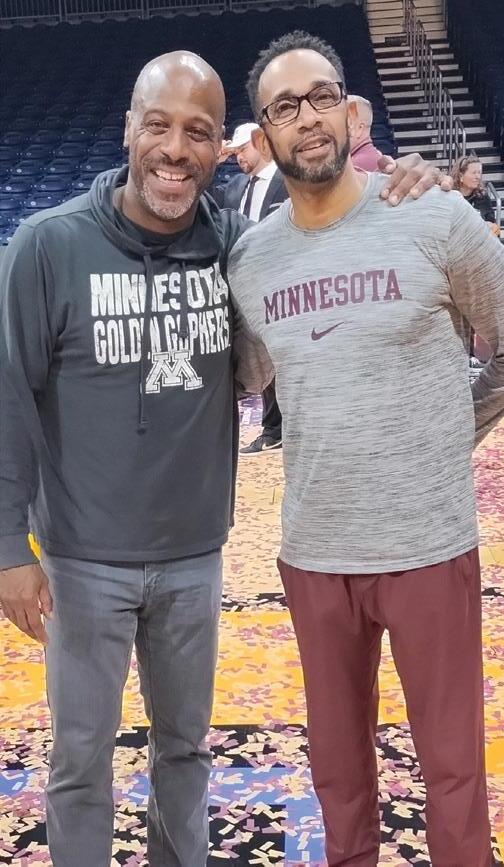


game press conference.
And from after the game:
hen Minnesota hosts Indiana this Friday, April 11 in women’s tennis, 2 of the handful of Black head coaches will face each other for the first time this season.
Using boxing lexicon, here is the diversity tale of the tape: Indiana’s Gabrielle Moore is in her first season at Indiana, and this is Lois Arterberry’s second season at Minnesota. Both Black women are seasoned coaching veterans.
lieving that she is ready for the pros, said Hagemann in a recent MSR interview.
“I had some ups and downs,” she pointed out, “but overall it has been successful, and I learned a lot in my four years I’ve been at college.”
Since her collegiate career concluded a few weeks ago, Hagemann said she has been working on her strengths and minimizing her weaknesses as she prepares for the next step in her career, hopefully as a pro guard.
“I’m trying to get a lot stronger,” she said, “because I know the pro league, no matter if it’s the WNBA or overseas, I got to put my weight up a little bit.”
“I am so proud of these girls. It’s a team effort,” said Nolana Holloway.
“I wish we would have played
Jim Shikenjanski, former Gopher MBB player (198690): “I love any Minnesota sport that can win and compete and continue playing on when so many teams are done playing.”
well enough to be in the Big Dance, but it still feels good to win one, so I’m excited for them,” said Terrell Battle.
“Certainly, we have a ton of respect for Belmont. They are a matchup nightmare. But our young ladies played with a great deal of resilience,” Minnesota Coach Dawn Plitzuweit told us before she went to the post-

Therefore, both the gym and the weight room have served as a second home. “Just staying consistent in the weight room. Just staying in a gym, working on my handles,” she stressed.
“Working on my jump shot to improve that and make them more consistent,” she added.
Hagemann said she hadn’t at the time of our phone interview heard from any WNBA folk, but according to her agent, her college coach at Memphis has
been in contact with pro people.
“I’m ready to take what I learned in college and take that [to the pros],” said Hagemann.
A well-traveled career
One WNBA mock draft board has Diamond Johnson, the 5’5” senior guard from Norfolk State, going high in the third and final round next week. Whether or
“My daughter’s a winner. Always been, and it doesn’t surprise me what she did as the lights go brighter. She accepts the challenge,” said Charles Thomas McKinney of his daughter Tori. “I’m super proud of her.”
“There’s nothing I would have changed this season or the
people I got to play with. It’s just an amazing group, and it’s such a genuine group,” added Tori McKinney.
“Only three teams out of the whole NCAA get to finish on a win, and we were one of them. I think that’s what we’re most grateful for. And we worked really hard for it, so we deserved
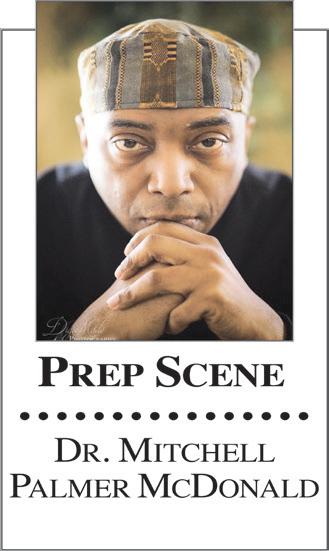
uring the 1990-91 girls basketball season, this prep sports columnist was a young sports reporter for Insight News covering the Minneapolis City Conference.
decided to get there early, meaning the girls would be playing. Keep in mind that my conversation with Starks and her teammate weeks before was a distant memory.
That changed rather quickly as Starks, then a junior guard, scored 13 of her game-high 17 points leading North to a 65-55 victory, despite a 34-point effort by Henry sophomore and future University of Georgia Hall of Fame player Tracy Henderson. Flash forward to 2020: After her success as an AAU coach for the Metro All Stars — where she coached former Hopkins

Moore and Arterberry are just 2 of 14 Black female head tennis coaches in college. According to the NCAA, this is eight below the all-time high of 22 (2020 and 2021).
Moore began her coaching career at Lake Forest College (2015-16), then as Jackson State assistant coach for both their men’s and women’s tennis teams in 2016. She was then promoted to head coach of both squads the following season. The Southern University

grad with a biology degree was a standout tennis player, a four-time all-SWAC player, and helped her team win four straight conference titles and two NCAA appearances.
After six seasons at Jackson State, where she won as coach two SWAC regular season titles and the 2022 conference postseason crown, Moore left for McNeese State for two seasons, where she posted a school-best 20 wins (20-4) in 2023-24.
Arterberry also is a Southern grad with a bachelor degree in business management (2013) and a masters in business administration (2015). Before she went into coaching as a grad assistant at the school, Arterberry was a three-time conference champion. and played in three straight NCAAs (2011-13).
The second-year Gopher coach, who was hired in 2023, was a two-year assistant coach at Missouri and an assistant for one season at UNC-Asheville before two head coaching stints — Jackson State (men’s

and women’s, 2015-17) and Eastern Illinois (2017-18).
At Jackson State, Arterberry won a conference title (men’s, 2016) and reached consecutive HBCU Championship finals (women’s, 2016 and 2017).
She moved up north and coached at St. Thomas, her third head coaching opportunity, during its transition from Division III to Division I.
On Friday, the two Southern alums will lead their respective
While covering a North boys game, two girls approached and made me aware of the fact that I hadn’t been giving the girls the same coverage as the boys. Both indicated with passion that they played for Minneapolis North.
One player was more passionate than the other and posed a question: “When are you going to come watch us play?” she asked.
“Soon,” I replied. “By the way, what is your name?”
“Tara Starks.”
In case you’re wondering, yes, that Tara Starks! The same Tara Starks who today stands as one of the state’s top coaches for Hopkins High School.
A few weeks later, Minneapolis Patrick Henry was scheduled to play conference archrival North in a boys contest. During this time period, the girls’ varsity game was always played before the boys. With the Henry-North boys game consistently packed with standing-room-only crowds, I
and current UCONN great Paige Bueckers — and assistant coaching stops at Minneapolis North and Hopkins, Starks accepted the head coaching position at Hopkins.
What has she done since then? Starks has led the Royal to four consecutive Class 4A championship games with runner-up finishes in 2023 and 2024, and titles 2022 and 2025. Hopkins’ most recent championship — won after defeating Maple Grove 81-67 — is special because they avenged two losses to arch rival Wayzata by defeating them in the Section 6 championship game to qualify for the state tournament.
In what has been accomplished during her first five years at Hopkins, Starks is well established as one of the state’s top coaches. I just wanted to make sure that people knew that she also had game.
Dr. Mitchell Palmer McDonald welcomes reader comments to mcdeezy05@gmail.com.